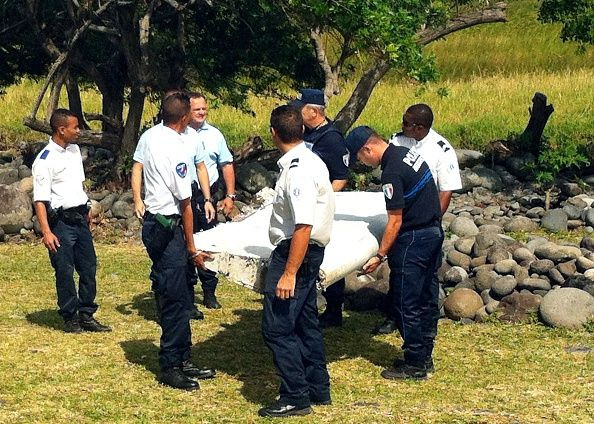Does Debris Belong To Flight MH370? How The Experts Will Know

As airplane debris washed ashore on the island of Réunion in the Indian Ocean on Wednesday, the intense speculation surrounding the disappearance of Malaysian Airlines Flight 370 over 16 months ago seemed to be drawing to a close. Initial reports suggest that the appearance of the debris is consistent with the design of the Boeing 777 model that was MH370, and authorities should be able to quickly confirm whether the wing flap that washed ashore in Réunion came from the missing Malaysian flight.
While the process of determining the identity of the debris has just begun, experts suggest that information on the rest of the plane could soon follow, along with how and why it disappeared. Each plane contains serial registration numbers for every piece and component, making it easy to identify its origin.
Glenn Winn, an aviation security specialist and professor in the aviation security program at the University of Southern California’s Viterbi School of Engineering, said that identity of the debris as MH370 should be released between 12 to 24 hours, speculating that Boeing had already sent engineers on a flight to Réunion to check the serial numbers on the airplane debris.
“It shouldn’t take any time once a Boeing representative gets on the ground,” Winn said.
Determining whether or not the debris is from the aircraft is relatively easy and straightforward, said Patrick Smith, a pilot familiar with Boeing aircrafts.
Malaysian Flight 370 disappeared near Vietnam on March 8, 2014 after departing form Kuala Lumpur, Malaysia, to Beijing with 227 passengers and 12 crew members, prompting an international search effort led by Australia. If the plane is confirmed to have crashed without any survivors, it will be the deadliest aviation incident involving a Boeing 777.
Boeing said in a statement that remained “committed to supporting the MH370 investigation and the search for the airplane,” and that it would continue to share its technical expertise and analysis with investigators to “determine what happened – and why,” but did not comment on the process to confirm that the Réunion debris came from MH370.
As Boeing makes a plane, each factory making an individual piece will put on distinctive marks and identifying numbers that could be linked to the overall aircraft. Rather than rely on a single serial number for the whole plane, each part retains its own code so a factory responsible for a faulty mechanism can be easily determined after an accident.
Although debris from MH370 would have been submerged in salt water for over 16 months, potentially corroding the parts, manufacturers place multiple protective overcoats on identifying details for preservation, making it unlikely that the wing flap that came ashore would not be able to be immediately identified.
The debris appears to be a flaperon or wing flap that contains an element unique to Boeing 777 aircrafts, according to CNN, which would almost certainly indicate that it is a part of MH370. While the serial numbers will be able to definitively confirm the flaperon’s identity, Boeing 777 aircrafts are relatively rare and records have accounted for the whereabouts of all the planes that have been made except for MH370.
Guillaume de Syon, a professor of aviation history at Albright College, said that if a 777 had lost a wind flap then it would have been recorded as a major incident, eliminating the possibility of the debris coming from another plane.
“If this flap is indeed confirmed as coming from a 777, there’s a very good chance that it did come from the flight that went missing,” said de Syon.
De Syon also speculated that more pieces could be found after officials have ascertained the water currents pushing the debris, leading to even more information on how the plane crashed. The flaperon washed up over 4,000 miles from where the plane disappeared, making it far outside where the crash was expected.

As more pieces are discovered, engineers from the National Transportation Safety Board (NTSB), a United States agency responsible for investigating transportation accidents including plane crashes, will work with engineers from Boeing to determine what happened to the plane, Winn said. By looking at the “tear factor on the metal, the trailing on the particular hinge” they will be able to “tell whether it’s been torn off the plane or bent off,” and from that determine how MH370 may have crashed.
“They do so much radical testing to make sure that parts don’t come off,” Winn said. “It would take an incredible amount of force” to separate it from the plane. “It will come down to engineers to figure out what happened.”
While the investigation has just begun, de Syon was optimistic about the discovery of the piece, suggesting that it could finally solve the mystery of what happened to MH370.
“It’s good news for families of those on the flight and everyone involved in the search that they found that piece,” de Syon said. “People need some sense of closure.”
© Copyright IBTimes 2025. All rights reserved.






















